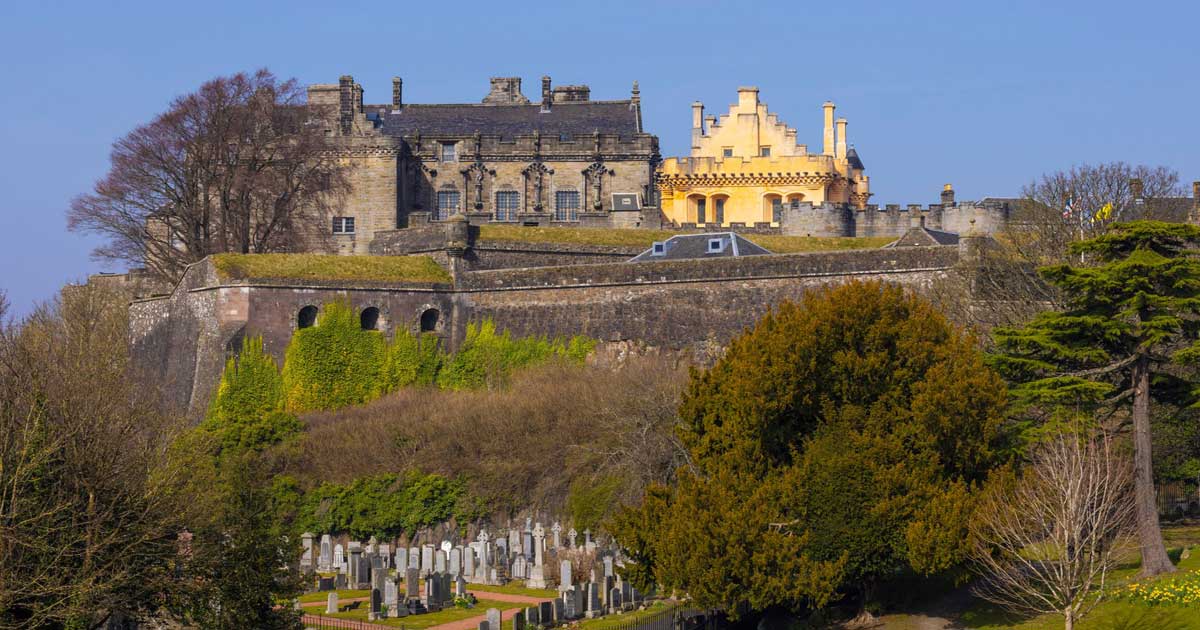
Key Historical Events at Stirling Castle
Stirling Castle has played a pivotal role in Scotland’s history for centuries. It was the guardian of the wild and untamed route to the Highlands of Scotland.
As a royal residence, military stronghold, and site of major battles, it has witnessed some of the nation’s most defining moments. Below are five key events that shaped the legacy of the fortress.
- 1297 – William Wallace’s victory at the Battle of Stirling Bridge. He led Scottish forces to a decisive victory against the English near Stirling Castle, solidifying his status as a national hero.
- 1314 – Robert the Bruce wins the Battle of Bannockburn. His army defeated the English near Stirling Castle, securing Scotland’s independence for a generation.
- 1543 – Mary, Queen of Scots crowned at Stirling Castle. At just nine months old, she was crowned in the Chapel Royal, marking the start of her tumultuous reign.
- 1625 – Charles I becomes the last king crowned in Scotland Charles I. Also the last Scottish king to have a separate coronation in Scotland, he stayed at Stirling Castle before his reign led to civil war.
- 1651 – Stirling Castle falls to Oliver Cromwell. During the Wars of the Three Kingdoms, Cromwell’s forces captured Stirling Castle, marking a turning point in Scotland’s struggle against English rule.
Stirling Castle history
Over the centuries, three major battles have been fought in the castle’s immediate vicinity; with another important one taking place just a few miles to the north. It has been besieged or attacked 16 times.
Stirling Castle as it stands today is of course not the original. While the date that the building first began remains unknown; the recorded endowment of a castle chapel by Alexander I between 1107 and 1115 gives us an accurate historical starting point.
Over the following years, his name appears again in the castle annals giving us an indication that Stirling Castle was one of his favourite residences. He died there in 1124.
The castle has changed hands numerous times, like a medieval game of ping-pong, sometimes in Scottish hands, sometimes in English.
In 1174, on a raid into English territory, William the Lion was captured and held prisoner. In return for his release Henry II demanded that in return for his freedom, Stirling Castle and four other castles were turned over to him as part of the Treaty of Falaise.
It was a degrading experience for the Scots. The castles were eventually returned when the treaty was rescinded in 1189
During the late 13th and early 14th century, the fortress became the focus of a country at war when the death of a king triggered a period of bitter rivalry, bloody cross-border fighting and ultimately changed the course of Scotland’s history.
Monday 18 March 1286, was a stormy day in eastern Scotland. Alexander III was safely behind the protective walls of Edinburgh Castle, relaxed after dining with his nobles.
However, rather than remaining overnight in Edinburgh, he chose, against the advice of his aides, to return to his castle at Kinghorn on the other side of the Firth of Forth.
On a wild and pitch-black night the 40 year old king, perhaps anxious to return to his young wife set off accompanied by his squires.
It seems that somewhere along the dangerous route he became separated from the others.
In the morning they found his body, neck broken, at the bottom of a cliff apparently thrown from his horse. It was a death foretold by the soothsayer Thomas the Rymer.
Margaret the Maid of Norway
Four years later Alexander’s only direct heir, his granddaughter, Margaret the Maid of Norway also died leaving no direct claimant to the Scottish crown.
With 13 competing claimants for the Scottish throne, among them, John Balliol and Robert Bruce, Edward I of England was asked to arbitrate.
He arrived at Stirling Castle in 1291 to wait for approval from Scottish nobles that they would all accept his role.
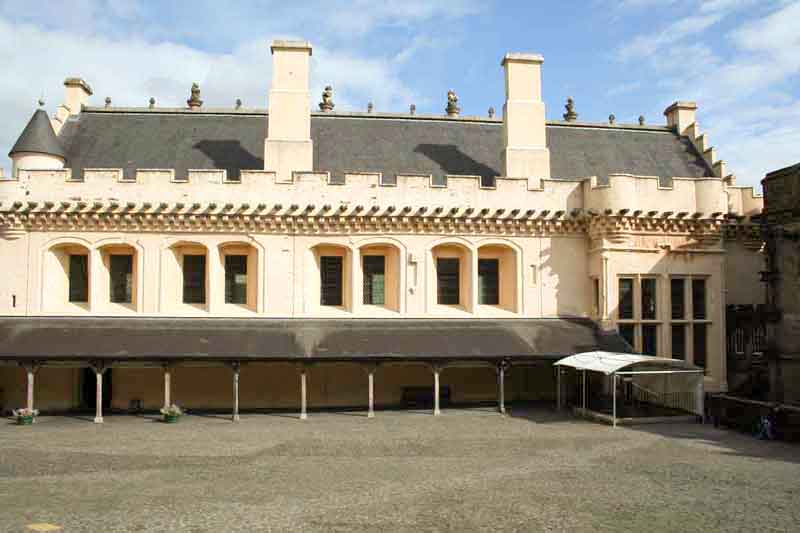
Edward chose John Balliol but with the crown came certain conditions, England’s monarch demanded support, from Scotland’s new king, particularly in times of war.
However, in 1295, with England again at war with France, King John refused to give that support.
John Balliol was taken prisoner
A furious Edward swept north in retaliation, determined that John be made to pay for his lack of co-operation. His campaign was successful, Balliol was taken prisoner and deposed, and once again Stirling Castle was in English hands.
The Wars of Independence had begun and Scots come together to challenge the might of the English crown. It was time for William Wallace who “raised his head” and gathered support for a retaliatory strike.
Battle of Stirling Bridge
The Scottish victory at the Battle of Stirling Bridge in 1297, fought within sight of the Castle, raised William Wallace to hero status.
He was a man of “giant stature and extraordinary strength” and his followers loved him. Wallace was knighted after the battle.
While there is no denying the bravery and tactical awareness of Wallace during the battle he must have been grateful for the inept planning of the English commander.
The Earl of Surrey, who instead of crossing the River Forth at a much broader point up river sent his knights across Stirling Bridge, a narrow wooden structure. Able to cross only two abreast they were easily picked off by the waiting Scots.
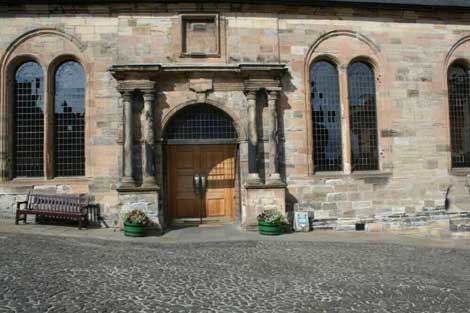
The euphoria created by Wallace’s triumph was sadly short lived, for Edward’s epithet the Hammer of the Scots was well earned; he was back in Scotland at the head of another army within a year looking for revenge.
In the early months of 1298 Wallace, in the absence of a monarch, became Guardian of Scotland. However, it is a source of continuing debate among historians as to why he chose to abandon his hit and run tactics and stop to face Edward’s vastly superior army.
Battle of Falkirk
His subsequent defeat at the Battle of Falkirk meant he would never again wield substantial power or influence. An abandoned Stirling Castle was once more in English hands.
After his defeat at Falkirk Wallace gave up his Guardianship and was replaced by Robert the Bruce and John Comyn of Badenoch.
They were an unlikely pair of bedfellows and as far apart politically as it was possible to be.
It was immediately obvious that this arrangement wouldn’t work and a third senior and neutral Guardian was added to the mix. He was Bishop Lamberton of St Andrews.
William Wallace sentenced to death
Wallace was eventually captured by the English and sentenced to death as a traitor. His death sentence, a gruesome affair, was carried out in 1305, in London in front of a large crowd.
He was dragged through the streets before being hanged, cut down still living, castrated, disembowelled, and decapitated.
His body was quartered with the parts taken to Newcastle, Berwick, Perth and back to the scene of his greatest triumph at Stirling. His head was displayed on London Bridge.
Putting their differences aside the Guardians assembled an army and once more laid siege to Stirling Castle, which was surrendered when it became obvious that there was no relief from the south.
Over the next decade, the castle continued to change hands and the fight for the vacant Scottish throne grew more savage. In early February 1306 Bruce and Comyn, in an attempt to resolve their differences, met in Greyfriars Church in Dumfries.
Bruce murdered Comyn
The meeting didn’t go well and the pair were soon arguing. Bruce in a rage stabbed his rival in the neck with his dagger, seriously wounding him.
He ran outside to his waiting comrades to explain what had happened and one of them, Sir Rodger Kirkpatrick, went inside to finish him off.
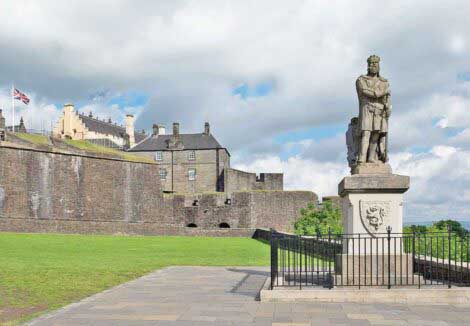
The murder of Comyn meant that there were no other serious rivals for the Scottish throne and Robert the Bruce was crowned at Scone on 25 March 1306.
His hated enemy Edward I, the Hammer of the Scots, died the following year and his son Edward II took the English throne.
Battle of Bannockburn
In 1314. the Scots were again hammering on the castle door demanding the surrender of the beleaguered English garrison. They gave them until Midsummer’s day to surrender.
Edward II, however, was eager to hold on to Stirling Castle and took up the challenge, and on a summer’s day in June, at the head of a 20,000 strong army, he crossed the River Tweed and headed north to Stirling.
He took a position between the River Forth and the Bannock Burn only two miles from the castle.
Scotland’s most celebrated battlefield victory over England came the following day at Bannockburn.
Perhaps the English soldiers were demoralised, whatever the reason the Scottish pikemen pushed them back towards the Forth where many of them drowned in a desperate attempt to escape.
Edward, what remained of his army, and the occupiers of the Castle fled. After the battle, the castle defences were destroyed in an attempt to stop them from being used again by the English.
Stewart kings: New construction
Many of the Stewart kings made changes to Stirling Castle: In 1463 James III undertook a range of construction, accounts show work on an unidentified White Tower and on the outer defences.
Although it is a matter of some debate among experts, it is thought his son James IV built the Great Hall.
He was also responsible for the King’s Old Building now used as a regimental museum for the Argyle and Sutherland Highlanders who were based in the castle until 1964.
The pace of reconstruction quickened at the start of the 16th century with James IV starting the work on the forework, a massive series of defensive towers and walls at the south end of the castle.
His death, at the age of 40, at the Battle of Flodden brought to an end the work of one of Scotland’s greatest builders of palatial architecture.
James V, only 17 months old, was crowned in the chapel less than two weeks after his father’s death. As an adult he began construction on the Palace (royal lodgings), later completed after his death by his widow Mary of Guise.
Mary Queen of Scots
Mary Queen of Scots, her son James VI, Oliver Cromwell, Bonnie Prince Charlie and many others have all left their indelible mark on the castle which remains one of the best surviving examples of late medieval and Renaissance architecture in Scotland.
The Royal Palace of Stirling Castle: A Renaissance Masterpiece
Among the most remarkable buildings within Stirling Castle is the Royal Palace, an exquisite example of Renaissance architecture built by James V for his queen, Mary of Guise, mother of Mary, Queen of Scots.
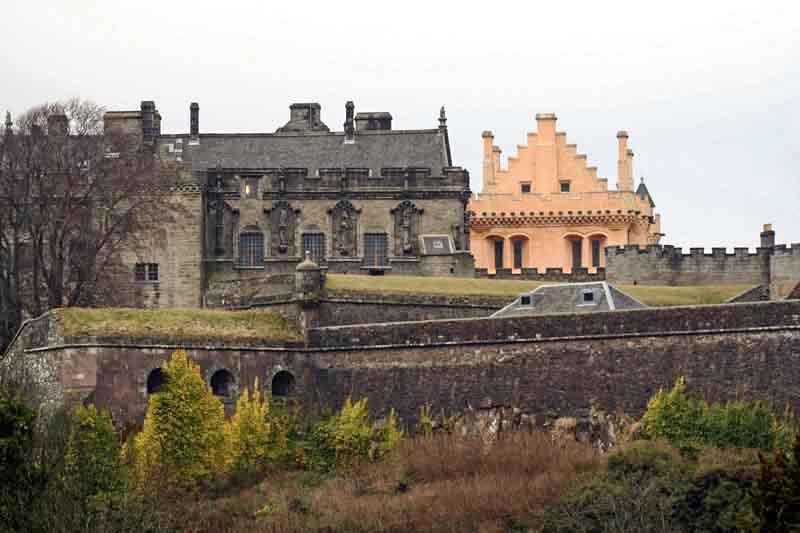
Construction began in 1538, but following James V’s death in 1542, his widow, Mary of Guise, oversaw its completion. The palace was not only a residence but also a symbol of royal power, blending French and Scottish influences in its design.
A Royal Residence
The palace was home to their infant daughter, Mary, Queen of Scots, who spent part of her early life within its walls. She returned in 1561 after her time in France to assume the Scottish throne.
The palace remained a royal residence until 1603, when James VI of Scotland (Mary’s son) moved his court to London after becoming James I of England.
By the time of Charles I’s reign, the palace was no longer in use by royalty.
Military Use and Restoration
In the 18th century, under Queen Anne, the palace was converted for military use. It housed soldiers for centuries, with the Argyll and Sutherland Highlanders being the last regiment stationed there until 1964.
Following the military’s departure, Stirling Castle slowly transformed into a visitor attraction. By 2000, a major restoration project began, aiming to recreate the palace’s 16th-century grandeur.
Restoring the Royal Palace
The palace’s restoration, completed in 2011, revived six royal apartments—three each for the king and queen—bringing them back to life with historically accurate decor and furnishings. Researchers used historical documents, European sources, and archaeological findings from 2003–2005 to ensure authenticity.
Notable features include:
• The Stirling Heads – A collection of hand-carved oak medallions featuring classical figures and Scottish monarchs. Over 30 originals, dating to 1530–1544, are displayed in a dedicated gallery.
• Unicorn Tapestries – Inspired by a 1539 inventory of James V’s tapestries, these detailed recreations hang in the Queen’s Inner Hall.
• The King’s Inner Hall – The throne room where only the most esteemed visitors were granted an audience.
A powerful reminder of Mary of Guise’s presence is a triptych in the Queen’s Bedchamber, depicting the Madonna and Child with St. Cecilia and St. Clare, crafted by a Leith-based artist.
Visiting the Royal Palace Today
Entrance to the Royal Palace is included with Stirling Castle tickets, allowing visitors to explore one of Scotland’s most impressive Renaissance buildings.
Conclusion
Stirling Castle’s long and complex history makes it one of Scotland’s most fascinating landmarks. From its role as a royal residence to its strategic military importance, the castle has shaped the nation’s story in countless ways.
Visitors today can explore its beautifully preserved architecture, uncover stories of Scottish monarchs, and take in breathtaking views of the surrounding landscape.
For more practical information, including travel details and key highlights, refer to the FAQs section below.
SIX frequently asked questions about Stirling Castle
Buses from Edinburgh Bus Station to Stirling take around one hour 30 minutes. If you prefer the train – the journey time from Edinburgh Waverley to Stirling is less than an hour for most trains. A further 10-15 minutes walk, mostly uphill, will take you to the castle.
Yes, Mary visited on a number of occasions. For example – only nine months old she was crowned Queen of Scots in the castle’s Chapel Royal. She was also there prior to the christening of her son James VI at the nearby church of the Holy Rude.
No, the Wallace Monument, dedicated to the life of one of Scotland’s greatest heroes, is located less than three miles from the castle.
The Bannockburn Visitor Centre, which tells the story of Robert the Bruce and Scotland’s greatest battlefield victory over an English army is located less than five miles from the castle.
The Stirling Heads are one of Scotland’s most important artistic treasures. Together they form an impressive collection of oak medallions carved with images of kings, queens, Roman emperors and characters from the Biblical and Classical worlds.
That’s a difficult one to answer because there’s so much to see. Certainly, the Royal Palace built by James V – a favourite place of his daughter Mary Queen of Scots – is a fascinating place to explore. Also, the Great Hall, completed for James IV and often the scene for magnificent state banquets should be on your itinerary too.
Stirling Castle: Visitor information
Stirling Castle is managed by Historic Environment Scotland (HES). As opening hours, ticket prices and accessibility information can sometimes change, please visit the official site by clicking the button below for the most up-to date information.